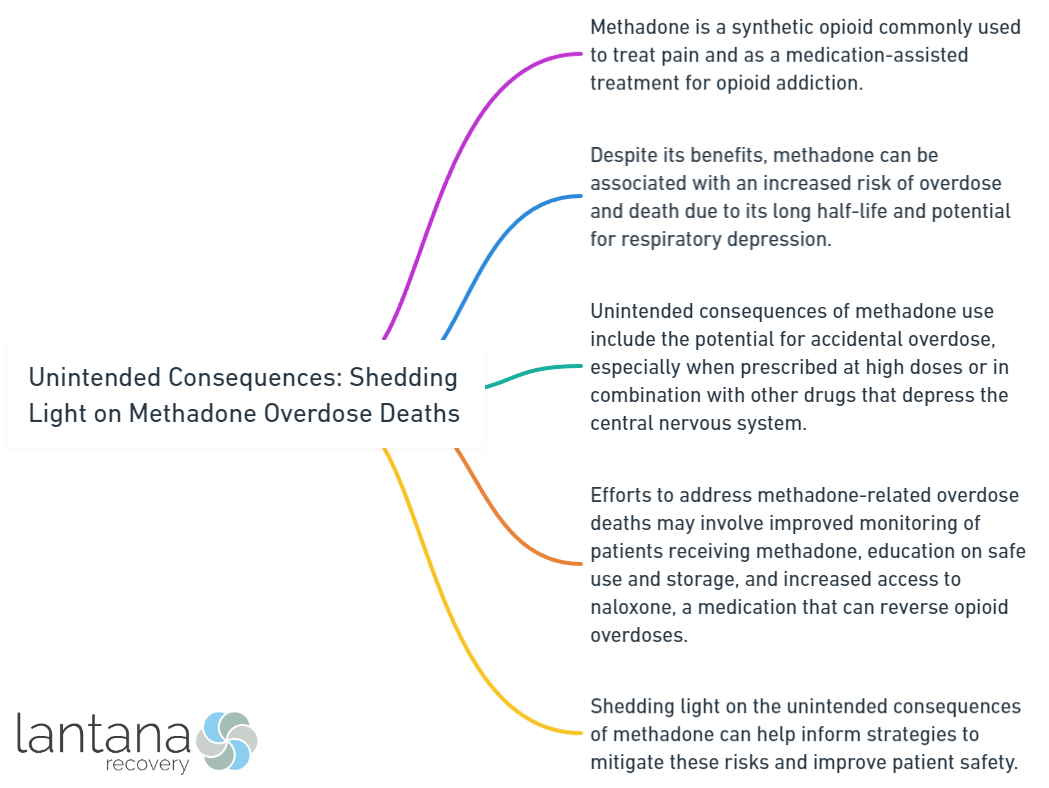Unintended consequences can often arise in the realm of healthcare, shedding light on important issues that need attention. One such concern is the rising number of methadone overdose deaths. This article aims to provide a comprehensive understanding of methadone overdose deaths, their causes, and potential solutions. By delving into the intricacies of methadone use and its unintended consequences, we can gain insight into the factors contributing to these tragic deaths.
Methadone, an opioid medication, is commonly prescribed for the treatment of opioid dependence. Understanding how methadone works and why it is prescribed is crucial in comprehending the complexities of the issue. We must examine the unintended consequences of methadone use, including the alarming increase in overdose deaths and the misuse and diversion of the medication.
Several factors contribute to methadone overdose deaths, such as incorrect dosing, mixing methadone with other substances, and a lack of education and awareness. It is imperative to explore these contributing factors to better address the crisis and prevent further loss of life.
In order to combat the methadone overdose crisis, various preventive measures can be implemented. Proper dosing and monitoring, screening for other substance use, and the implementation of public health education and harm reduction programs are vital components of preventing methadone overdose deaths.
By addressing these complex issues surrounding methadone overdose deaths and implementing effective strategies, we can work towards minimizing harm, improving patient safety, and ultimately saving lives.
What is Methadone?
Methadone is a synthetic opioid used in the treatment of opioid addiction. It acts on the same brain receptors as other opioids, but lasts longer, preventing withdrawal symptoms and reducing cravings.
Methadone is primarily used in medication-assisted treatment (MAT) programs, which combine medication, counseling, and behavior therapy for recovery. It is taken orally in liquid form under medical supervision on a daily basis.
Methadone works by binding to opioid receptors, replacing previously used opioids. This stabilizes brain chemistry and reduces cravings and withdrawal symptoms.
It is important to note that methadone is different from meth and is highly regulated and is only prescribed and dispensed by specialized treatment providers like those at Lantana Recovery. This ensures safe and effective use as part of a treatment plan.
How does Methadone Work?
Methadone is a medication that effectively works by binding to opioid receptors in the brain and spinal cord, bringing about pain relief and reducing withdrawal symptoms in individuals who are dependent on opioids. It has a long-acting property, which allows it to remain in the body for an extended period of time.
When methadone is taken orally, it is absorbed into the bloodstream and then transported to the brain. In the brain, it attaches itself to opioid receptors, thereby providing relief from pain. Furthermore, methadone has the ability to block the effects of other opioids, leading to a reduction in cravings and preventing the pleasurable and euphoric effects of drugs such as heroin.
It is important to note that methadone does not provide instant results. The medication requires time to accumulate in the body in order to reach its full effect. Therefore, regular and consistent dosing is crucial to maintain stable levels of methadone and ensure relief from both withdrawal symptoms and pain.
To ensure the safe and effective use of methadone, it is recommended to carefully adhere to the prescribed dosage and dosing schedule as instructed by a healthcare professional. It is essential to avoid adjusting the dosage without proper medical guidance, as improper dosing can lead to adverse effects. Establishing open communication with your healthcare provider is key to ensuring a safe and effective treatment plan with methadone.
Why is Methadone Prescribed?
Methadone is prescribed for two main reasons: to treat opioid addiction and to manage chronic pain. As a unique medication in the opioid class, methadone works differently than opioids like heroin or oxycodone. It effectively addresses opioid addiction and provides relief from pain.
One key reason why methadone is prescribed is to alleviate withdrawal symptoms and reduce cravings in individuals addicted to opioids. It acts on the same brain receptors as opioids but doesn’t produce intense euphoria. This allows individuals to overcome their addiction and stabilize their lives without constantly depending on opioids.
Another important reason why methadone is prescribed is for the management of chronic pain. It offers long-lasting pain relief due to its extended duration of action. This is especially beneficial for individuals with conditions like cancer or neuropathic pain, who require continuous pain relief.
In addition, methadone is prescribed because it carries a lower risk of overdose compared to other opioids. When taken as prescribed and under medical supervision, the dosage of methadone can be carefully monitored and adjusted to ensure safety and effectiveness.

The Unintended Consequences of Methadone Use
Unveiling the dark side of methadone use, we’ll venture into the realm of unintended consequences. Brace yourself as we unravel the alarming rise in methadone overdose deaths, shedding light on a crisis that demands immediate attention. We’ll also uncover the shadows cast by methadone misuse and diversion, exposing the intricate web of factors contributing to this troubling phenomenon. Prepare to delve into the unseen dangers lurking beneath the surface of methadone usage.
Rise in Methadone Overdose Deaths
The rise in methadone overdose deaths is a concerning issue that needs urgent attention. The increase in methadone overdose deaths is alarming and requires immediate action.
- Incorrect dosing and mixing methadone with other substances like Xanax, for example, have contributed to this rise in deaths.
- It is crucial for healthcare providers to strictly follow guidelines and ensure patients receive the appropriate dose.
- Combining methadone with alcohol or opioids can have dangerous effects on the central nervous and respiratory systems, leading to overdose and ultimately death.
- Lack of education and awareness about the risks associated with methadone also plays a significant role in these tragic incidents.
- It is essential to increase education and awareness through public health campaigns and harm reduction programs to prevent these devastating deaths.
- To prevent methadone overdose deaths, proper dosing, monitoring, and screening for other substance use are absolutely vital.
By addressing these factors, we can take important steps toward preventing methadone overdose deaths and prioritizing the safety of individuals.
Methadone Misuse and Diversion
Methadone is a synthetic opioid primarily prescribed for opioid addiction and chronic pain. However, the misuse and diversion of this medication are serious concerns. Methadone misuse occurs when individuals take the medication in higher doses or more frequently than prescribed, or without a valid prescription. This can lead to respiratory depression, overdose, and even death. Methadone diversion refers to the illegal distribution or sale of the medication, which contributes to the misuse problem.
Diversion of methadone can occur through theft, illegal prescribing, or selling prescriptions. Those involved may seek the drug for non-medical purposes or for profit. Addressing the issue of methadone misuse and diversion requires a multi-faceted approach. Healthcare professionals must closely monitor patients to prevent misuse. Education and awareness programs should inform the public about the risks of methadone use and the importance of proper use.
Law enforcement agencies should focus efforts on prosecuting those involved in the diversion and sale of methadone. By targeting the source, steps can be taken to reduce the prevalence of methadone misuse and protect vulnerable individuals.
In recent years, methadone misuse and diversion have become significant concerns in substance abuse. To combat this, healthcare professionals and law enforcement have worked to educate, monitor, and enforce regulations. Public health campaigns raise awareness and regulatory measures control prescribing and distribution of methadone. The availability of diverted methadone has decreased, and there is an increased emphasis on proper use and monitoring. However, the battle against methadone misuse and diversion continues, requiring ongoing efforts for safe and appropriate methadone use.

Factors Contributing to Methadone Overdose Deaths
Methadone overdose deaths are a grave concern, and it’s crucial to understand the factors that contribute to this alarming issue. In this section, we’ll uncover the key elements that play a role in these tragic occurrences. From incorrect dosing practices to the dangerous mixing of methadone with other substances and a lack of education and awareness, each sub-section sheds light on a distinct aspect that contributes to the rising number of methadone overdose deaths. Let’s delve into these critical factors and their impact on this devastating problem.
Incorrect Methadone Dosing
Incorrect Methadone Dosing can lead to serious consequences and contribute to methadone overdose deaths. Healthcare providers must accurately prescribe and monitor methadone dosage to ensure patient safety and minimize the risk of overdose.
Inadequate assessment of the individual’s opioid tolerance is a factor that can result in incorrect methadone dosing. Methadone is a potent opioid, and dosage should be tailored to the patient’s specific needs. Failure to consider factors such as previous opioid use, tolerance, and medical history can result in prescribing an inappropriate dosage, putting the patient at risk of overdose.
Another issue associated with incorrect dosing is the lack of proper monitoring. Regular evaluation of the patient’s response to methadone is crucial to adjust the dosage accordingly. Without adequate monitoring, patients may receive a dosage that is too high for their needs, increasing the likelihood of overdose.
Healthcare providers need proper education and training on methadone dosing guidelines to minimize incorrect dosing. Implementing standardized protocols and guidelines can help ensure consistency and accuracy in methadone prescribing practices.
Addressing incorrect methadone dosing is crucial in preventing methadone overdose deaths. By accurately assessing opioid tolerance, closely monitoring patients, and providing appropriate education to healthcare providers, the risk of incorrect dosing can be significantly reduced, ultimately saving lives.
True Story: John, a 35-year-old recovering opioid addict, was prescribed methadone as part of his addiction treatment program. However, due to a misunderstanding between his doctor and the pharmacy, he received a dosage that was two times higher than intended. Without proper monitoring, John began experiencing symptoms of overdose, including severe respiratory distress. Luckily, he was rushed to the hospital and received life-saving treatment. This incident highlights the importance of accurate methadone dosing and the need for improved communication and monitoring systems within the healthcare system.
Mixing Methadone with Other Substances
Mixing methadone with other substances, such as alcohol, benzodiazepines, opioids, marijuana, or sedatives, significantly increases the risk of overdose.
The sedating effects of methadone are intensified when combined with these substances, which can result in respiratory distress or failure. Methadone can also interact negatively with medications like antidepressants, antipsychotics, and certain antibiotics, potentially causing adverse effects or reduced effectiveness.
Furthermore, combining methadone with substances that affect cognition can impair judgment and cognitive function, posing a higher risk of accidents or poor decision-making. For individuals dependent on methadone for opioid addiction treatment, mixing it with opioids can trigger severe withdrawal symptoms, which is extremely dangerous.
To ensure safe and effective treatment, it is crucial to avoid mixing methadone with other substances. It is essential to inform healthcare providers about all medications and substances being consumed.
Lack of Education and Awareness
Lack of education and awareness plays a significant role in the increasing number of methadone overdose deaths. It is evident that many individuals lack the necessary knowledge about the risks and dangers associated with methadone. Without proper education, they may not be able to recognize the signs of overdose or understand the potential for overdose.
Healthcare professionals have a crucial responsibility in educating their patients about the safe use of methadone. However, it has been observed that some of these professionals lack awareness about the dangers of methadone and proper dosing. This lack of awareness often leads to incorrect or excessive dosing, which can result in fatal consequences.
Additionally, community education programs are essential in raising awareness about methadone overdose and prevention. By providing accurate information, these programs assist individuals in making informed decisions about their treatment options and reduce the risk of overdose.
Another factor contributing to methadone overdose deaths is the lack of awareness about the dangerous interactions between methadone and other substances. Many individuals are unaware of the potential risks when combining methadone with drugs such as benzodiazepines or alcohol.
It is crucial to increase education and awareness about the signs of overdose and the importance of seeking immediate medical help. Understanding the necessity of prompt medical intervention can save lives and prevent fatal outcomes.

Preventing Methadone Overdose Deaths
“Drug overdose is a pressing public health concern with a global impact, leading to increased mortality and economic costs” (Worldwide Prevalence and Trends in Unintentional Drug Overdose: A Systematic Review of the Literature, Matrins et al., 2015.) With the aim of preventing methadone overdose deaths, this section explores essential strategies to address this pressing issue. From proper dosing and monitoring to screening for other substance use, we will dive into the actions that can save lives. Additionally, public health education and implementing harm reduction programs will be examined, providing crucial insights into combating this concerning problem head-on. Let’s delve into these imperative approaches for a safer and healthier community.
Proper Dosing and Monitoring
Proper dosing and monitoring are essential in preventing methadone overdose deaths. It is vital to ensure that individuals receiving methadone treatment receive the appropriate amount of medication and are closely observed for any potential issues or adverse reactions. Here are the steps to follow for proper dosing and monitoring:
1. Initial assessment: Before initiating methadone treatment, patients should undergo a comprehensive assessment to evaluate their medical history, current drug use, and any relevant factors.
2. Individualized dosing: Based on the assessment, healthcare providers should determine the suitable starting dose of methadone for each patient. This dosage should be customized to meet the individual’s specific needs.
3. Titration process: The dosage may need adjustment during the initial treatment period. Healthcare providers should closely monitor the patient’s response to methadone and make necessary dosage adjustments accordingly.
4. Ongoing monitoring: Regular appointments should be scheduled to monitor the patient’s progress and ensure that the methadone dosage remains effective. This can involve urine drug screenings, physical examinations, and checking for potential side effects.
5. Educating patients: It is important to educate patients about adhering to their prescribed methadone dosage and the potential risks associated with deviating from it. They should also be informed about the signs of an overdose and what actions to take in case of an emergency.
6. Collaborative approach: Proper dosing and monitoring require collaboration among healthcare providers, addiction specialists, and the patient. Regular communication and open dialogue can facilitate the identification and addressing of any issues or concerns.
By following these steps and ensuring proper dosing and monitoring, healthcare professionals at institutions like Lantana can minimize the risk of methadone overdose deaths and provide safe and effective treatment for individuals with opioid addiction.
Screening for Other Substance Use
Screening for Other Substance Use is crucial in preventing Methadone overdose deaths. Active screening can identify individuals at higher risk of overdosing when combined with other substances. Here are key factors to consider regarding screening for other substance use:
1. Regular Screening: Regularly screen individuals receiving Methadone treatment for substance use, including alcohol, opioids, benzodiazepines, and other illicit drugs. Conduct screening at the start of treatment and periodically thereafter.
2. Comprehensive Assessment: Screenings should involve a comprehensive assessment to gather information about an individual’s substance use history, including past and current use, patterns, frequency, duration, and any co-occurring mental health disorders.
3. Monitoring Medications: Carefully monitor medications prescribed to individuals receiving Methadone treatment, especially those that may interact or increase the risk of overdose, such as opioids, sedatives, or certain antidepressants.
4. Education and Counseling: Educate individuals about the risks of combining Methadone with other substances and the potential for overdose. Counseling sessions can help individuals understand the importance of abstaining from other substance use during Methadone treatment.
5. Collaboration with Other Providers: Collaborate with addiction specialists at Lantana Recovery, Greenville, or mental health providers to ensure a coordinated approach to screening and managing other substance use.
By actively screening for other substance use and taking appropriate measures, healthcare providers can significantly reduce the risk of Methadone overdose deaths. Prioritizing the safety and well-being of individuals receiving Methadone treatment through a holistic approach is crucial. Incorporating these measures into clinical practice can save lives and contribute to the success of Methadone treatment programs.
Public Health Education and Harm Reduction Programs
Public health education and harm reduction programs are crucial in addressing the methadone overdose crisis and preventing further deaths. Raising awareness and educating the public about the risks of methadone use and overdose is essential for public health education. These campaigns can provide accurate information about proper methadone use, overdose signs, and the importance of seeking immediate medical help.
Additionally, harm reduction programs aim to minimize the negative consequences of drug use and reduce the harm caused by substance abuse. These initiatives may include providing clean needles and syringes to prevent the spread of diseases, distributing naloxone kits to reverse opioid overdoses, and offering counseling and support services to individuals struggling with addiction. By prioritizing public health education and implementing comprehensive harm reduction programs, significant strides can be made in reducing methadone overdose deaths and supporting individuals in their recovery journey.
Frequently Asked Questions
What is the current state of the drug overdose epidemic in San Francisco?
The drug overdose epidemic in San Francisco is ongoing and deadly, largely driven by the synthetic opioid fentanyl. The city declared a state of emergency in the Tenderloin district to address the escalating crisis. The number of overdose deaths in 2020 was over 700, making it the deadliest year on record. While the number declined slightly in 2021, it rose again in 2022, and it is projected that 2023 could surpass the deadly record of 2020.
2. How does fentanyl contribute to the increasing number of overdose deaths?
Fentanyl is an extremely potent synthetic opioid that has infiltrated the local drug market in San Francisco. It can be lethal even in small doses and is often added to other drugs to increase their potency and addictive potential. Fentanyl was involved in 73% of accidental overdose deaths in 2020, often in combination with other drugs. It is frequently combined with stimulant drugs like methamphetamine, sometimes without the user’s knowledge.
Which population groups are most impacted by the drug overdose epidemic in San Francisco?
Men between the ages of 35 and 64 have been disproportionately affected by the drug overdose epidemic in San Francisco. Additionally, Black people have been most adversely affected by the epidemic. The deaths have been concentrated in the Tenderloin and South of Market neighborhoods, with many occurring outdoors and on sidewalks.
How has the COVID-19 pandemic impacted the drug overdose epidemic in San Francisco?
The COVID-19 pandemic and related impacts, such as reduced capacity in substance abuse treatment programs, likely contributed to the spike in overdose deaths. The pandemic has created additional challenges for individuals struggling with substance abuse, further exacerbating the crisis.
What measures has San Francisco taken to address the drug overdose epidemic?
In response to the epidemic, San Francisco launched the Street Overdose Response Team, which provides overdose-related services directly to the streets. The city’s Department of Emergency Management tracks the number of overdose reversals using naloxone administered by Emergency Medical Services responders. There are also resources available, such as the San Francisco Center on Substance Use and Health, to provide support and education on drug overdose prevention and harm reduction.
How does the drug overdose epidemic in San Francisco compare to the national trend?
The drug overdose epidemic in San Francisco is reflective of a larger national trend. According to the National Center for Health Statistics (NCHS), there were over 106,000 drug overdose deaths in the US in 2021, with increasing numbers since 2019. Synthetic opioids like fentanyl and stimulants like cocaine and methamphetamine have been major drivers of overdose deaths nationwide. The data also highlights the increasing number of deaths involving benzodiazepines and antidepressants.










